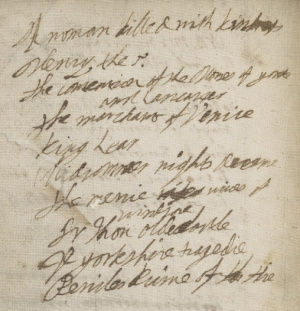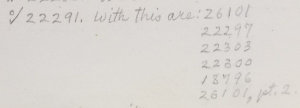Miss Orlebar copy of the Pavier quartos
The Miss Orlebar copy of the Pavier quartos, also known as the "Percy-Caledon copy," no longer exists as an intact volume. It hasn't been intact since some time before May 8, 1763, when Thomas Percy (1729-1811) recorded that King Lear had been removed. Two other plays had also been removed by that time: The Yorkshire Tragedy and Thomas Heywood's A Woman Killed with Kindness. The remaining plays were re-bound together in the 19th century, then separated and re-bound as six individual volumes at the Folger in 1963.
Percy records that the volume was given to him by "Miss Orlebars," one of three sisters of the Orlebar family of Hinwick Hall, Bedfordshire, most likely the eldest, Mary Orlebar (1730–1821). [1] Before Miss Orlebar, the volume was almost certainly owned by Thomas Goodman (died 25 December 1738).[2]
Original order of binding

Presumably, the original order of binding matched the order in the manuscript table of contents on the verso of the front fly-leaf of what is now Folger call number STC 26101 copy 2:
- A Woman Killed with Kindness (current location unknown)
- Henry V (now Folger STC 22291 copy 7)
- Henry VI, Part 2, as the first part of The Whole Contention Between the Two Famous Houses, Lancaster and York...Divided into Two Parts (now the first part of Folger STC 26101 copy 2)
- Henry VI, Part 3, as the second part of The Whole Contention Between the Two Famous Houses, Lancaster and York...Divided into Two Parts (now the second part of Folger STC 26101 copy 2)
- The Merchant of Venice (now Folger STC 22297 copy 4)
- King Lear (current location unknown)
- A Midsummer Night's Dream (now Folger STC 22303 copy 6)
- The Merry Wives of Windsor (now Folger STC 22300 copy 7)
- Sir John Oldcastle (now Folger STC 18796 copy 3)
- A Yorkshire Tragedy (current location unknown)
- Pericles (now the third part of Folger STC 26101 copy 2)
Disposition on 16 April 1739
Quarto lot 1452/3 in A Catalogue of the entire Library of Dr. Thomas Goodman, Late Physician in Ordinary to His Majesty...to be Sold by Auction...at Fletcher Gyles's.[3]
Disposition on 8 May 1763
A note in Thomas Percy's hand on the front fly-leaf reads:
- NB. Miss Orlebars made me a present of this book with a view that I shd. give it to my friend Mr. Garmer, who was collecting Quarto Editions of Shakespeare plays. I accordingly sent it dow[n] [t]o him at Cambridge, but whe[n] [h]e came to examine the volume he found that he was already possessed of every play in it except King Lear, which he therefore took out, & sent me back the Volume. [two and a half lines of text that was later obliterated follow]. May 8. 1763. T. P.[4]
Disposition after 8 May 1763, but before 30 September 1811
The obliteration was evidently done by Bishop Percy (died 30 September 1811) because it's in the same ink as a continuation of the note, in his hand, at the bottom of the same page:
- 3 Plays taken out of this volume
- viz.
- 1. Woman killed with Kindness
- 2. King Lear
- 3. Yorkshire Tragedy
Re-binding circa 1850
The eight plays remaining in the collection after A Woman Killed with Kindness, King Lear, and A Yorkshire Tragedy had been removed were re-bound around 1850 (date of rebinding estimated by Folger staff member Giles Dawson in 1963), maintaining the order of the manuscript table of contents.[5]
- Henry V (now Folger STC 22291 copy 7)
- Henry VI, Part 2, as the first part of The Whole Contention Between the Two Famous Houses, Lancaster and York...Divided into Two Parts (now the first part of Folger STC 26101 copy 2)
- Henry VI, Part 3, as the second part of The Whole Contention Between the Two Famous Houses, Lancaster and York...Divided into Two Parts (now the second part of Folger STC 26101 copy 2)
- The Merchant of Venice (now Folger STC 22297 copy 4)
- A Midsummer Night's Dream (now Folger STC 22303 copy 6)
- The Merry Wives of Windsor (now Folger STC 22300 copy 7)
- Sir John Oldcastle (now Folger STC 18796 copy 3)
- Pericles (now the third part of Folger STC 26101 copy 2)
Disbinding in 1963
A typed note bound at the end of Folger STC 26101 copy 2 (The Whole Contention and Pericles) signed and dated G.E. Dawson, 24 September 1963, describes the disbinding as follows:
- These three plays were, when H.C. Folger acquired them, bound together with Merchant (22298), M. Wives (22300), Midsummer (22303), Henry V, (22291), and Oldcastle (18796), all being Pavier quartos of 1619. These eight, together with three others, were once in a volume which belonged to Bishop Percy, whose note on the recto of the old fly-leaf gives a partial history of the volume. King Lear is there accounted for; what happened to the Woman Killed and the Yorkshire Tragedy is not clear, but since the list of plays removed (unlike the long list on the verso) is in Percy's hand, they were presumably in the volume that Miss Orlebars gave away. After the volume was broken up Percy may have kept the eight plays unbound. At any rate the binding which the Folger binder [that is, Robert Lunow] removed (calf with blind decorations) appeared to have been done about 1850. Therefore the order of the plays in the last binding could not have been significant, and I have ignored it. For that matter, the presence of the non-Pavier Woman Killed pretty well guarantees that the original collector had no special plan in view and therefore that the arrangement in Miss Orlebars's volume was hit or miss. It may safely be assumed that the original order is shown in the list on the verso of the old fly-leaf.
- The 1850 binding was perfectly sound and satisfactory. The decision to break it up arose from the extreme tenderness of many of the leaves caused by the use of the volume, at some time after 1850, for the pressing of botanical specimens and the resulting mildew.
- For the Earl of Caledon's possession of the volume, see an article by Van Lennep in the 1964 Shakespeare Quarterly anniversary volume.[6]
A collation provided by Dawson follows, along with a note that "the other five plays will be found in bindings roughly uniform with this one." The other volumes have a much shorter note, referring the reader to this one for additional information.
The other five are:
- The Merchant of Venice (Folger STC 22297 copy 4)
- The Merry Wives of Windsor (Folger STC 22300 copy 7)
- A Midsummer Night's Dream (Folger STC 22303 copy 6)
- Henry V (Folger STC 22291 copy 7)
- Sir John Oldcastle (Folger STC 18796 copy 3)
Notes
- ↑ Kitamura Sae, The Role of Women in the Canonization of Shakespeare: From Elizabethan Theatre to the Shakespeare Jubiliee," Ph.D. Dissertation, King's College, London, 2013, pages 236-7.
- ↑ Zachary Lesser, Ghosts, Holes, Rips and Scrapes: Shakespeare in 1619, Bibliography in the Longue Durée (Philadelphia: University of Pennsylvania Press in cooperation with the Folger Shakespeare Library, 2021). For Goodman's date of death, see The Gentleman's Magazine, December 1738, p. 660.
- ↑ Page 166.
- ↑ It appears to be signed "G. P." because Percy's majuscule T looks like a conventional majuscule G. For confirmation see for example Y.c.1542 (1), a letter in his handwriting signed "Thomas Percy".
- ↑ Confirmed by Folger staff annotation in three copies of A.W. Pollard, Short Title Catalog of Books Printed in England.... (London: Bibliographical Society, 1926). Call numbers Z2002 .P7 1926 Acq; Z2002 .P7 1926 Copy 2 Cat. Dept.; and Z2002 .P7 1926 Copy 3 Cat. Dept.
- ↑ In fact, the article was by John F. Fleming. See Fleming, John F. “A Book from Shakespeare's Library Discovered by William Van Lennep.” Shakespeare Quarterly, vol. 15, no. 2, 1964, pp. 25–27. JSTOR, www.jstor.org/stable/2867870.
